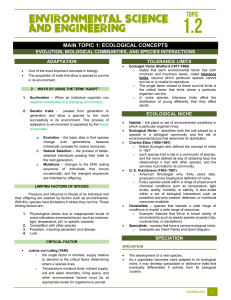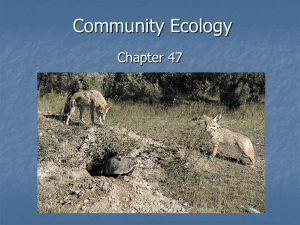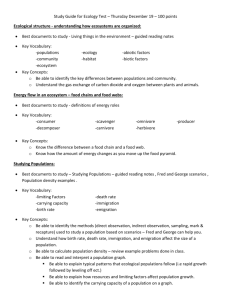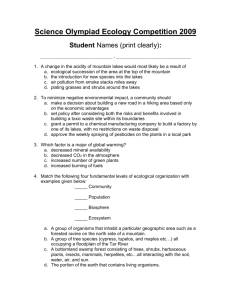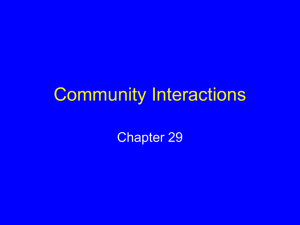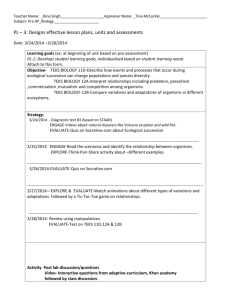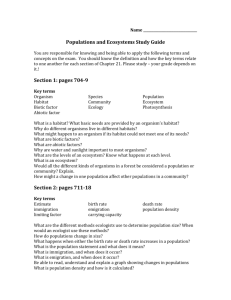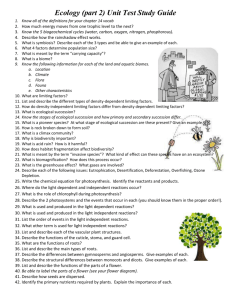Populations, Communities, and Species Interaction
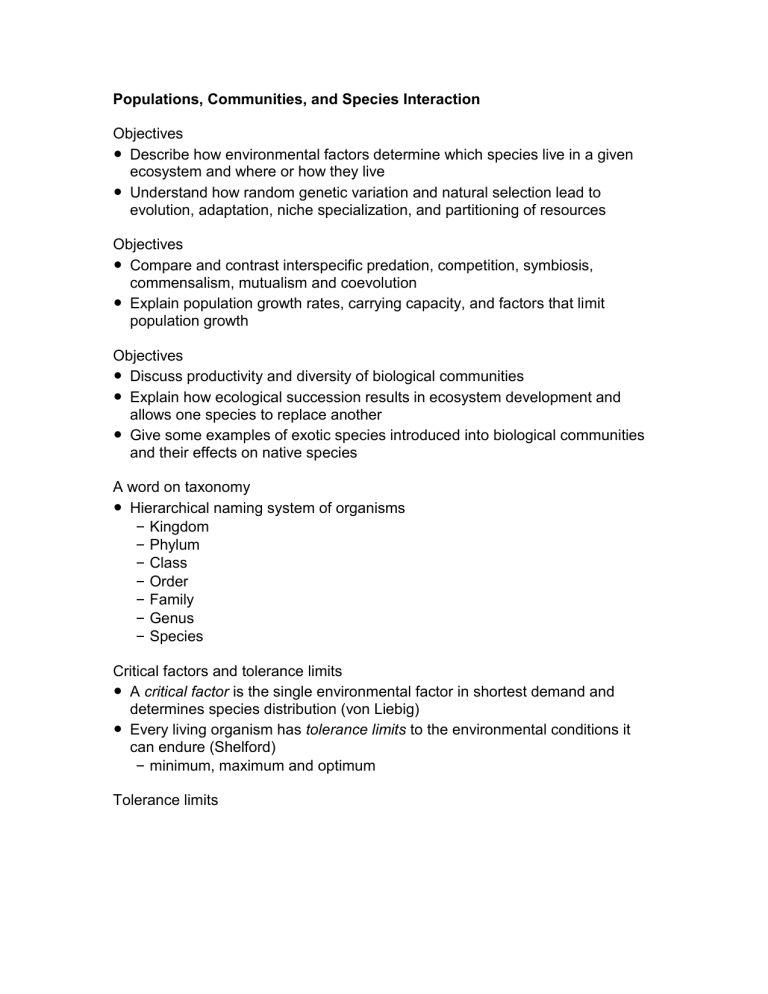
Populations, Communities, and Species Interaction
Objectives
•
Describe how environmental factors determine which species live in a given ecosystem and where or how they live
•
Understand how random genetic variation and natural selection lead to evolution, adaptation, niche specialization, and partitioning of resources
Objectives
•
Compare and contrast interspecific predation, competition, symbiosis, commensalism, mutualism and coevolution
•
Explain population growth rates, carrying capacity, and factors that limit population growth
Objectives
•
Discuss productivity and diversity of biological communities
•
Explain how ecological succession results in ecosystem development and allows one species to replace another
•
Give some examples of exotic species introduced into biological communities and their effects on native species
A word on taxonomy
•
Hierarchical naming system of organisms
–
Kingdom
–
Phylum
–
Class
–
Order
–
Family
–
Genus
–
Species
Critical factors and tolerance limits
•
A critical factor is the single environmental factor in shortest demand and determines species distribution (von Liebig)
•
Every living organism has tolerance limits to the environmental conditions it can endure (Shelford)
–
minimum, maximum and optimum
Tolerance limits
Critical factors and tolerance limits
•
For many species, the interaction of several factors, rather than a single limiting factor, determines biogeographical distribution
–
For some organisms, there may be a specific critical factor that mostly determines abundance and distribution
Critical factors and tolerance limits
•
Species requirements and tolerances can also be used as useful indicators
–
Environmental indicators
Adaptation
•
Adapt is used in two ways:
–
Range of physiological modifications available to individual organisms - acclimation
•
Individual level
–
Inheritance of specific genetic traits allowing a species to live in a particular environment
•
Population level
–
Explained by process of evolution
Evolution
•
Species change gradually through natural selection, a process whereby those members of a population that are best suited for a particular set of environmental conditions will survive and produce offspring
– “survival of the fittest”
Natural selection
•
Process in which better competitors survive and reproduce more successfully
•
Acts on pre-existing genetic diversity
•
Limited resources place selective pressures on a population
Artificial selection
Speciation
•
Given enough geographical isolation or selective pressure (from natural selection), members of a population become so different from their ancestors that they may be considered an entirely new species
Evolution
•
Divergent evolution - Mutations and different selective pressures cause populations to evolve along dissimilar path
Galapagos finches
Evolution
•
Convergent Evolution - Unrelated organisms evolve separately to cope with environmental conditions in the same fashion
–
Look alike - Act alike
Ecological niche
•
Habitat - Place or set of environmental conditions where a particular organism lives
•
Ecological Niche - Description of the role a species plays in a biological community, or the total set of environmental factors that determines species distribution
–
Generalists - Broad niche
–
Specialists - Narrow niche
Resource partitioning
•
Law of Competitive Exclusion - No two species will occupy the same niche and compete for exactly the same resources for an extended period of time
–
One will either migrate, become extinct, or partition the resource and utilize a sub-set of the same resource
•
Given resource can only be partitioned a finite number of times
Resource partitioning
•
Apparent competitors may actually have slightly different niches
•
Species may use resources in a different way or time
•
Minimizes competition and allows coexistence
Species interactions
•
A predator is an organism that feeds directly upon another living organism, whether or not it kills the prey in doing so
–
Prey most successfully on slowest, weakest, least fit members of target population
•
Reduce competition, population overgrowth, and stimulate natural selection
–
Co-evolution
Coevolution
– “Arms race”
•
Natural selection promotes traits that help prey escape predation
•
It also promotes traits that make predators more successful at capturing prey
Prey defenses
•
Chemical
•
Camouflage
•
Warning coloration
•
Mimicry
Chemical
Camouflage
Warning coloration
Mimicry
•
Mullerian Mimicry - Two unpalatable species evolve to look alike
Mimicry
•
Batesian mimicry - Harmless species evolve characteristics that mimic unpalatable or poisonous species
Keystone species
•
Keystone Species - A species or group of species whose impact on its community or ecosystem is much larger and more influential than would be expected from mere abundance
Keystone species
Symbiosis
•
Symbiosis - Intimate living together of members of two or more species
–
Commensalism - One member benefits while other is neither benefited nor harmed
–
Mutualism - Both members benefit
–
Parasitism - One member benefits at the expense of other
Commensalism
Mutualism
•
Both species benefit
•
Some mutualisms are obligatory
Yucca and yucca moth
•
An obligatory mutualism
•
Each species of yucca is pollinated by only one species of moth
•
Moth larvae can grow only in that one species of yucca
Acacia and ants
•
Ants get nectar and a place to live
•
Ants provide protection and reduction in competition
Parasitism
•
Parasites drain nutrients from their hosts and live on or in their bodies
•
Natural selection favors parasites that do not kill their host too quickly
Types of species interactions
Population ecology studies characteristics of populations and how these characteristics affect the growth of populations
Population
•
Populations can be described by vital statistics or demographics
–
Size
–
Age Structure
–
Density
–
Distribution
Population age structure
•
Divide population into age categories
Population size
•
Number of individuals that contribute to a population’s gene pool
Changes in population size
•
Immigration & Births add individuals
•
Emigration & Deaths subtract individuals
Limits to population growth
•
Population growth is simply the change in numbers per change in time
•
A popula tion’s growth depends on the resources of its environment
–
If resources are unlimited, then growth will be exponential
–
If resources are limiting, then growth will be logistic r
•
Net reproduction per individual per unit time
•
Can be used to calculate rate of growth of a population
Exponential growth model dN/dt = rN
• dN/dt = population growth per unit time
• r = intrinsic rate of increase
•
N = number of individuals in population
Limits to population growth
•
A population’s growth depends on the resources of its environment
•
A limiting factor is any essential resource that is in short supply
•
All limiting factors acting on a population dictate sustainable population size
Carrying capacity (K)
•
Maximum number of individuals that can be sustained in a particular habitat
•
Logistic growth occurs when population size is limited by carrying capacity
Logistic growth
•
Growth rates regulated by internal and external factors until coming into equilibrium with environmental resources
–
Population growth rate slows as population approaches carrying capacity
–
S-shaped curve
Logistic growth model dN/dt = rN
Community properties
•
Primary productivity - Rate of biomass production
–
Used as an indication of the rate of solar energy conversion to chemical energy
–
Net Primary Productivity - Energy left after respiration
Abundance and diversity
•
Abundance -Total number of organisms in a community
•
Diversity - Number of different species, ecological niches, or genetic variation
–
Abundance of a particular species often inversely related to community diversity
–
As general rule, diversity decreases and abundance within species increases when moving from the equator to the poles
Edges and boundaries
•
Ecotones
– boundaries between adjacent communities
•
Edge effects - Important aspect of community structure is the boundary between one habitat and others
–
Some organisms are very sensitive to edges
Ecological succession
•
Change in the composition of species over time
Primary Succession
Ecological succession
•
Primary Succession - A community begins to develop on a site previously unoccupied by living organisms
•
Pioneer Species
Pioneer species
•
Species that colonize barren habitats
•
Lichens, small plants with brief life cycles
•
Improve conditions for other species who then replace them
Primary succession
Ecological succession
•
Secondary Succession - An existing community is disrupted and a new one subsequently develops at the site
–
Old Field Succession
Invasive (exotic/introduced) species
•
Species that has left its home range and become established elsewhere
•
Has harmful effects on a community
•
70 percent of endangered species have been negatively affected by invasive competitors
Nile perch in east Africa
•
Nile perch were introduced into Lake Victoria as a food source
•
This predator ate native cichlids; drove many species to extinction
•
Now Nile perch species is close to crashing
Rabbits in Australia
•
Rabbits were introduced for food and hunting
•
Without predators, their numbers soared
•
Attempts at control using fences or viruses have thus far been unsuccessful
Kudzu in Georgia
•
Imported for erosion control
•
No natural herbivores, pathogens, or competitors
•
Grows over landscapes and cannot be controlled
Mongoose in Hawaii
•
Released to control rats
•
Rats are nocturnal and Mongooses are diurnal
•
Both are now problems

